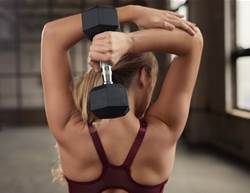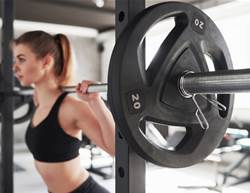For years I was a cardio junkie. I’d run up to 80 kilometres per week–until I got injured and my doctor gave me a stern warning: if I didn’t take a break, the injury might not heal and could get worse. So, I started doing three days of light weightlifting and three days of low-impact cardio. It was gentler on my joints, plus I became stronger and still worked my cardiovascular system.
Light weight training hasn’t worked just for me–it’s worked for women of all ages and fitness levels. I’m an exercise physiologist and I’ve seen it in data I’ve collected from conducting numerous research studies on resistance-training programs over the past decade.
These six low-impact resistance-training exercises (keep reading) can help you learn new mobility patterns, raise your heart rate, tone muscles and even lose weight if combined with low-impact cardio and smart nutrition choices.
To kickstart your body transformation, do 16 reps of each routine and then begin discovering the amazing benefits of strength training.
The full body benefits of lifting light weights
A strength training program like this one, which works the whole body, can spark some powerful changes, such as:
- Lowering body fat, reducing weight and sculpting a leaner physique.
- Preserving and building lean muscle mass.
- Improving your bone density.
- Lowering your risk of injury and achy joints.
- Supporting your heart health.
- Building a stronger core and improving balance.
- Reducing your risk of diabetes.
- Boosting your mood and protecting your brain.
How to choose the right weights
I’ve found that dumbbells in the 2–4kg range work best, but your sweet spot may be lower or higher.
Your ideal weight should be heavy enough that it feels hard to get through the last few reps. At the end of a set, you should feel as if it was challenging and uncomfortable, but still doable. If you finish a set feeling that you could easily do more reps, your weight is too light.

Sumo squat to upright rows
What it works: Quadriceps, glutes, inner thighs, core and shoulders
Setup: Stand tall with your feet more than hip-width apart and toes pointing out to the sides. Hold a dumbbell in each hand, arms dangling in front of your body.
- Keeping your chest lifted, bend your knees and sink into a squat. Drop as low as you can, optimally until your thighs are parallel to the floor. Hold momentarily.
- Driving from your heels, return to starting position, squeezing inner thighs and tightening your glutes (buttocks).
- Pull both dumbbells up your torso, winging your elbows out to the sides. Finish with your elbows slightly below shoulder height, with the dumbbells at your sternum.
- Lower the dumbbells down your torso to return to the starting position. That’s one rep.

Lunge back to bicep curls
What it works: Quadriceps, glutes, core, biceps and balance
Set-up: Hold a dumbbell in each hand, arms by your sides. Stand tall with your shoulders over your hips and your legs hip-width apart, toes facing forward.
- Step your left foot back into a deep lunge.
- Squeeze your glutes and return your back foot to the set-up position, keeping the majority of your weight on the supporting leg to challenge your balance.
- Bend elbows and draw dumbbells toward your shoulders in a bicep curl.
- Extend your arms down to your sides to return to the starting position. Repeat on the other leg. That’s one rep.

Lunge back to overhead tricep extensions
What it works: Quadriceps, glutes, core, shoulders, triceps and balance
Set-up: Hold a dumbbell in each hand, arms by your sides. Stand tall with your shoulders over your hips and your feet hip-width apart, toes facing forward.
- Step your right foot back into a deep lunge.
- Squeeze your glutes and return your back foot to the set-up position, keeping the majority of your weight on the supporting leg to challenge your balance.
- Raise your arms above your head so they’re close to your ears. Bend your elbows and lower the dumbbells behind your head until they touch (or nearly touch) your shoulders. Keep your elbows pointing forward and not out to the sides.
- Extend both elbows to return dumbbells overhead and then lower them to the set-up position. Repeat on the other leg. That’s one rep.

Squat to presses
What it works: Quadriceps, glutes, core and shoulders
Set-up: Stand with your shoulders over your hips and your legs slightly more than hip-width apart, toes facing forward. Hold your dumbbells so they’re level with your collarbones (shoulder height).
- Keeping your chest lifted and your spine tall, bend your knees and sink into a squat, tracking your knees in the same direction as your toes. Drop as low as you can, optimally deeper than 90 degrees. Hold momentarily.
- Squeeze your glutes and rise to the starting position.
- Keeping your legs and core motionless, raise the dumbbells overhead so your wrists are straight over your shoulders.
- Return to the starting position with dumbbells held at your collarbones. That’s one rep.

Hip abduction to lateral shoulder raises
What it works: Sides of glutes, outer thighs, core and sides of shoulders
Set-up: Hold a dumbbell in each hand, resting your hands and the weights on your outer thighs. Stand tall with your shoulders over your hips and your legs hip-width apart, toes facing forward.
- Flex one foot and lift that leg out to the side, away from the midline of your body.
- Return the leg to the set-up position.
- Keep your arms straight and lift the dumbbells up and away from your body until you make a ‘T’ shape. Hold momentarily.
- Slowly lower the dumbbells back to your outer thighs. Repeat on the opposite side. That’s one rep.

Deadlift to scaptions
What it works: Hamstrings, lower back, glutes, core, upper back and backs of the shoulders
Set-up: Hold a dumbbell in each hand, arms dangling in front of your body. Stand tall with your shoulders over your hips and your feet hip-width apart, toes facing forward.
- Hinge at your hips and glide the dumbbells down the fronts of your thighs. Maintain just a tiny bend in your knees. Keep your back flat.
- Squeeze your glutes, push through both feet and rise up to the starting position.
- Without bending your arms, lift them up to form a ‘V’ while squeezing your upper back muscles together tightly. Hold momentarily.
- Release the contraction in your upper back and return your arms to the starting position. That’s one rep.
Weight training is most beneficial when you also regularly do aerobic activities, such as walking, jogging, cycling or swimming.
Weight training images by Philip Friedman.









